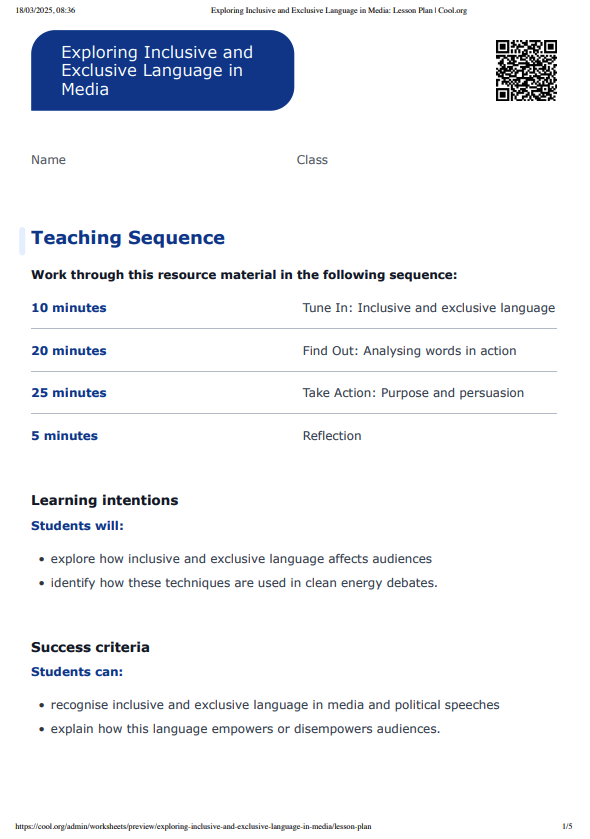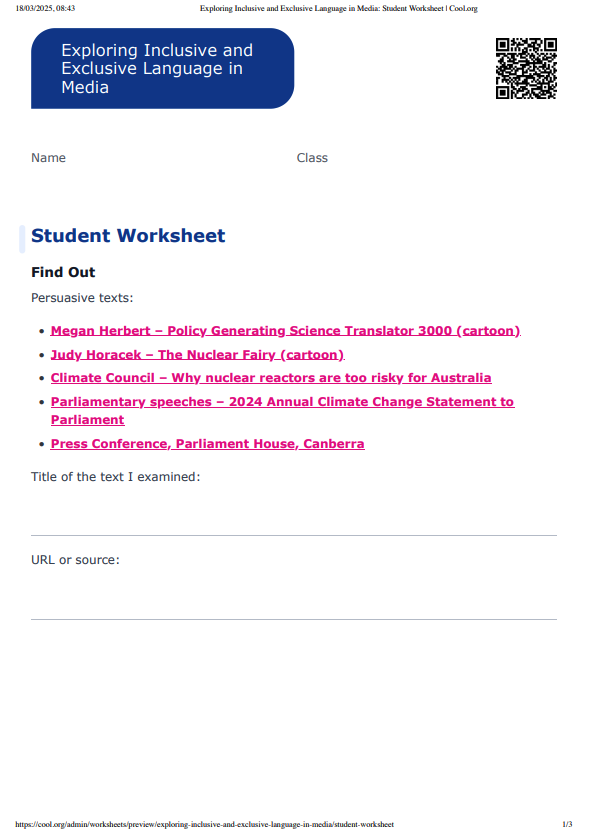Lesson summary
Students will learn to recognise inclusive and exclusive language use in various persuasive texts by exploring political speeches, debates and political cartoons to analyse the author or speaker’s persuasive intent.
Learning intentions
Students will:
- explore how inclusive and exclusive language affects audiences
- identify how these techniques are used in clean energy debates.
Success criteria
Students can:
- recognise inclusive and exclusive language in media and political speeches
- explain how this language empowers or disempowers audiences.
Lesson guides and printables
Curriculum links
Select your curriculum from the options below.
Lesson details
Skills
This lesson is designed to build students’ competencies in the following skills:
- adaptability
- creative thinking
- critical thinking
- communication
- global citizenship
- reflection
Curriculum Mapping
Australian Curriculum (v9.0) content description:
Year 9, English
Students learn to:
- recognise how language empowers relationships and roles (AC9E9LA01).
Year 10, English
Students learn to:
- understand how language can have inclusive and exclusive social effects, and can empower or disempower people (AC9E10LA01).
Relevant parts of Year 9 English achievement standards: Students select and experiment with language features including literary devices, and experiment with multimodal features and features of voice.
Relevant parts of Year 10 English achievement standards: Students select, vary and experiment with language features including rhetorical and literary devices, and experiment with multimodal features and features of voice.
NSW Syllabus outcomes:
A student:
- extends Tier 2 and Tier 3 vocabulary through interacting, wide reading and writing, morphological analysis and generating precise definitions for specific contexts (EN3-VOCAB-01).
General capabilities: Critical and Creative Thinking, Digital Literacy, Literacy, Personal and Social Capability, Ethical Understanding
Cross-curriculum priority: Sustainability
Level of teacher scaffolding: Medium - the teacher is required to facilitate class discussion and model skills.
UN Sustainable Development Goals
- Target 4.7: By 2030, ensure that all learners acquire the knowledge and skills needed to promote sustainable development, including, among others, through education for sustainable development and sustainable lifestyles, human rights, gender equality, promotion of a culture of peace and non-violence, global citizenship and appreciation of cultural diversity and of culture’s contribution to sustainable development.
- Target 16.5: Substantially reduce corruption and bribery in all their forms
- Target 16.10: Ensure public access to information and protect fundamental freedoms, in accordance with national legislation and international agreements.
Resources Required
- Student devices
- Student Worksheet
- Whiteboard
Additional Info
Cool.org thanks our philanthropic funder, Boundless Earth for their generous contributions and collaboration in creating these resources.



Welcome back!
Don't have an account yet?
Log in with:
Create your free Cool.org account.
Many of our resources are free, with an option to upgrade to Cool+ for premium content.
Already have an account?
Sign up with:
By signing up you accept Cool.org's Terms and Conditions(Opens in new tab) and Privacy Policy(Opens in new tab).